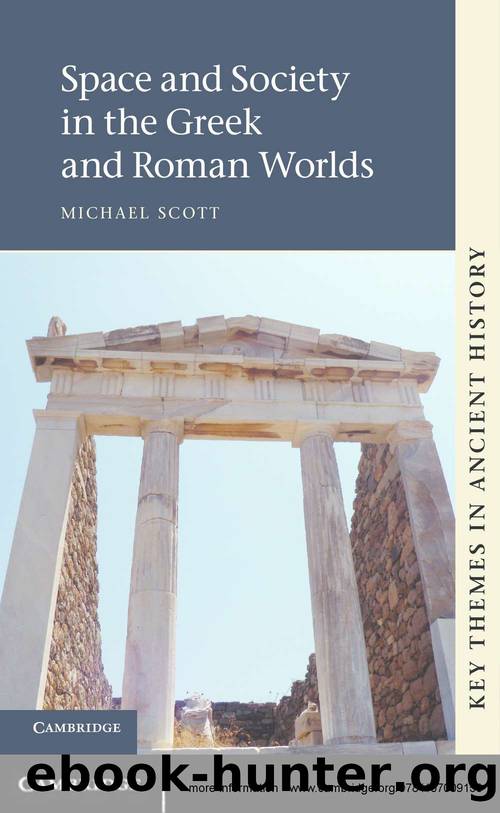Space and Society in the Greek and Roman Worlds (Key Themes in Ancient History) by Michael Scott

Author:Michael Scott [Scott, Michael]
Language: eng
Format: azw3
Publisher: Cambridge University Press
Published: 2012-11-30T00:00:00+00:00
Architecture, art and trade
If the urban spatial layout of Syracuse and Corinth does not prove to be an arena in which satisfactory comparisons can be made, what can we say about the varying conceptions of architecture and architectural space developed in the two cities? The geographical region around Syracuse is renowned for the fact that it produces a limestone that closely resembles Greek poros stone (cf. Mertens 1990: 374). While this may well, as a result, have produced built structures that had a greater visual affinity with their Greek mainland counterparts, there were also several crucial points of difference between Syracuseâs architecture and that of its metropolis that would have impacted on the sense of distance between them.
In contrast to the Doric temple of Apollo constructed at Corinth soon after the middle of the sixth century BC (Dinsmoor 1927: 87), at Syracuse, through to the end of the sixth century, a very âSyracusanâ style of architecture developed. For example, the style of much of the surviving archaic revetment material from the early sixth century BC is unique to Syracuse (Barletta 1983: 71). The temple of Apollo, constructed on Ortygia c.565 BC (Figure 4.1), shows an âindependence from rigid specifications of mainland Doric modelsâ (Barletta 1983: 73). Coulton has moreover argued for the creation of a specific âSicilian ruleâ for the design of the temple stylobate in contrast to the rule for the Greek mainland (Coulton 1974: 82â3). In addition, Sicilian builders made a particularly emphatic use of stone: the stone columns are huge and accompanied by a dedicatory inscription in which, uniquely, the architect specifically responsible for the columns boasts about them as âbeautiful worksâ (Berve and Gruben 1963: 416; Mertens 1990: 378). During the course of the sixth century, the Eastern Mediterranean influence on Syracusan architecture increased substantially. The temple of Zeus Olympius (c.555 BC), the stepped altar of Athena in the Athenaion on Ortygia (550â525 BC), along with the never-completed Ionic temple parallel to the later temple of Athena (525â500 BC), all demonstrate significant Eastern, particularly Samian and Ephesian, influences (Barletta 1983: 78, 86â8; Holloway 1983: 271; Cerchiai et al. 2004: 206).
It is not only the style of the architectural elements that creates this very individual Syracusan look, but the overall conception of architectural temple space as well. The internal architecture of the temple of Apollo at Syracuse, for example, was so arranged as to maximise open space (Mertens 1990: 379), in a way very different from that seen on the mainland (Mertens 1996: 324), and particularly in the temple of Apollo at Corinth (cf. Figure 4.2). Yet this may be more than simply a âwillingness to accept external influencesâ (Mertens 1990: 383). Such a change in the architectural space of the temple has been explained by a possible difference in ritual practice from that of the mainland (Barletta 1983: 75). It has also been attributed to a subtle shift in the purpose of monumental sacred architecture. Whereas monumentalisation in mainland Greece arguably signalled the central importance of
Download
This site does not store any files on its server. We only index and link to content provided by other sites. Please contact the content providers to delete copyright contents if any and email us, we'll remove relevant links or contents immediately.
| Africa | Americas |
| Arctic & Antarctica | Asia |
| Australia & Oceania | Europe |
| Middle East | Russia |
| United States | World |
| Ancient Civilizations | Military |
| Historical Study & Educational Resources |
The Daily Stoic by Holiday Ryan & Hanselman Stephen(2703)
The Fate of Rome: Climate, Disease, and the End of an Empire (The Princeton History of the Ancient World) by Kyle Harper(2429)
People of the Earth: An Introduction to World Prehistory by Dr. Brian Fagan & Nadia Durrani(2345)
Ancient Worlds by Michael Scott(2098)
Babylon's Ark by Lawrence Anthony(2066)
Foreign Devils on the Silk Road: The Search for the Lost Treasures of Central Asia by Peter Hopkirk(2053)
India's Ancient Past by R.S. Sharma(1982)
MOSES THE EGYPTIAN by Jan Assmann(1968)
The Complete Dead Sea Scrolls in English (7th Edition) (Penguin Classics) by Geza Vermes(1836)
Lost Technologies of Ancient Egypt by Christopher Dunn(1796)
The Daily Stoic by Ryan Holiday & Stephen Hanselman(1764)
The Earth Chronicles Handbook by Zecharia Sitchin(1742)
24 Hours in Ancient Rome by Philip Matyszak(1675)
Alexander the Great by Philip Freeman(1642)
Aztec by Gary Jennings(1540)
The Nine Waves of Creation by Carl Johan Calleman(1518)
Curse Tablets and Binding Spells from the Ancient World by Gager John G.;(1509)
Before Atlantis by Frank Joseph(1481)
Earthmare: The Lost Book of Wars by Cergat(1465)
